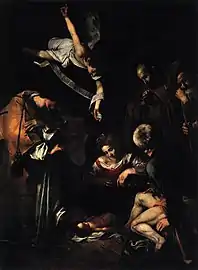Giovanni Ravalli
Giovanni Ravalli (21 September 1909 – 30 April 1998) was an Italian military officer who was imprisoned for war crimes he committed during the Axis occupation of Greece during World War II. Following a pardon, he served as police prefect of Palermo, investigating the theft of Caravaggio's Nativity with St. Francis and St. Lawrence.
Giovanni Ravalli | |
|---|---|
| Born | 21 September 1909 Sicily, Kingdom of Italy |
| Died | 30 April 1998 (aged 88) Rome, Italy |
| Allegiance | |
| Service/ | |
| Rank | Lieutenant |
| Unit | 24th Infantry Division Pinerolo |
Army service
Giovanni Ravalli was born on 21 September 1909 in Sicily, Italy. During the course of World War II, Ravalli served in the 24th Infantry Division Pinerolo, 13th Infantry Regiment, in the rank of Lieutenant.[1] In this capacity he became the head of intelligence of the Italian garrison in the city of Kastoria, Greece. Despite the heavy presence of the Italians in Kastoria, its outskirts remained in the control of EAM-ELAS guerrillas which in turn received wide support from local Greeks, Slavic speakers, Vlachs and elements of the collaborationist Hellenic Gendarmerie. Ravalli went on to establish links with Andon Kalchev's Ohrana (a pro-Bulgarian Slavic-speaking militia) and German troops stationed at Florina, disarming the Gendarmerie in order to cut short ELAS' weapon supply. In July 1943, ELAS stepped up its attacks around Kastoria, exploiting a period of Italian passivity. News of the Allied invasion of Sicily caused a drop in morale among Ohrana's ranks, leading to desertions. In August, the Pinerolo Division began to gradually withdraw from Kastoria as Italy was on the edge of signing an armistice with the Allies. Ravalli surrendered to ELAS along with 15 Ohrana members.[2]
Trial and imprisonment
Following the end of World War II, in 1948 Greece and Italy signed a secret treaty according to which Greece would abstain from prosecuting Italian war criminals, with Ravalli being the only Italian prosecuted by the Special War Criminals Court in Athens. Several trials against Italians were conducted at the local courts for collaborators.[3] Trials against Italian war criminals responsible for atrocities committed on the Ionian Islands were initiated only in 1967 and were halted prematurely due to the passage of the statute of limitations for enforcement of the penalty.[4]
Ravalli was tried by the Special War Criminals Court of Athens, with proceedings beginning on 18 February 1946. Ravalli was convicted of:[4]
- Taking part in a meeting with Carabinieri commander Emilio Jona and colonel Venieri during which the decision was taken to kill 50 Greek citizens as a punitive measure
- Failing to inform his superiors about a series of murders committed by the Ohrana as well as the routine use of torture by the Italian army in the Kastoria prison as well as during counter-insurgency operations
- Imprisoning civilians in inhumane conditions without a probable cause
- Failing to inform his superiors of looting committed by the Italian army and the Ohrana
- Terrorizing the local population through wanton arrests and house searches
- Taking part in executions
The prosecutors focused strongly on Ravalli's arming of the Slavic population of Kastoria, an issue that sparked heated debates within the public opinion. Accusations were leveled by the press also against the EAM/ELAS, accused of fostering Macedonian independentism at Tito's orders.[5] On 10 June 1946, Ravalli was sentenced to a total of three life sentences, his possessions were confiscated by the state and he was ordered to pay the costs arising from the trial.[6]
Ravalli served his sentence in prisons located in Kozani and Thessaloniki. In 1959, he was pardoned by the Greek government after Italy threatened to halt the payment of war reparations.[2][7] News of his release led to public outrage in Kastoria, its citizens sent a protest telegram to King Paul of Greece.[2]
Postwar career

Following his return to Italy, Ravalli was appointed police prefect of Palermo.[7] In October 1969, two thieves entered the Oratory of San Lorenzo in Palermo and stole Caravaggio's Nativity with St. Francis and St. Lawrence from its frame. Experts estimated its value at $20 million.[8][9] Ravalli played a prominent role in the unsuccessful investigation and gained a reputation for combating the Sicilian mafia, while also serving as an advisor to the Italian prime minister. He died on 30 April 1998, having retired to his home at 179 Via Cristoforo Colombo, south Rome.[7]
Notes
- Gasparinatos 2015, pp. 427–429.
- Sfetas 2000, pp. 350–359.
- Conti 2011, pp. 5–97.
- Gasparinatos 2015, pp. 427–436, 392.
- Fonzi 2012, p. 34.
- Gasparinatos 2015, pp. 427–432, 392.
- Rory Caroll (25 June 2001). "Italy's bloody secret". Guardian. Retrieved 25 March 2018.
- "FBI — Caravaggio". Fbi.gov. 2012-09-17. Archived from the original on 2012-10-20. Retrieved 2012-11-18.
- Sooke, Alastair (23 December 2013). "Caravaggio's Nativity: Hunting a stolen masterpiece". BBC website. Retrieved 24 December 2013.
References
- Conti, Davide (2011). Criminali di Guerra italiani. Accuse, processi e impunità nel secondo dopoguerra (in Italian). Rome: Odradek. ISBN 978-8896487143.
- Gasparinatos, Spyros (2015). Οι Ελληνικές Κατοχικές Κυβερνήσεις - Δίκες Κατοχικών Δοσίλογων και Εγκληματιών Πολέμου [Greek Occupation Governments - Trials of Collaborationists and War Criminals] (in Greek). Athens: Estia. pp. 1–494. ISBN 9789600516517.
- Fonzi, Paolo (2012). ""Liquidare e dimenticare il passato". I rapporti italo-greci 1943 – 1948". Italia Contemporanea. 266 (266): 7–42. doi:10.3280/IC2012-266001.
- Fonzi, Paolo (2021). "Political Violence in a Borderland. The Region of Kastoria under Italian Occupation (1941-1943)". Journal of Balkan and Black Sea Studies. 6: 75–99.
- Sfetas, Spyridon (2000). "Η ίδρυση και η δράση της Οχράνας (1943-44) στη δυτική και κεντρική Μακεδονία, στα πλαίσια της πολιτικής της VMRO και των ιταλο-γερμανικών αρχών Κατοχής" [The foundation and operation of Ohrana (1943-44) in western and central Macedonia, in the framework of VMRO's and Italo-German occupational authority's policies]. Valkanika Symmeikta. Thessaloniki: Institute for Balkan Studies: 343–376. Retrieved 8 March 2018.